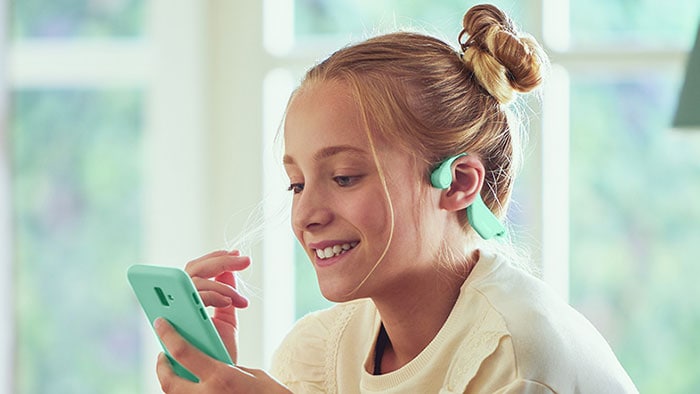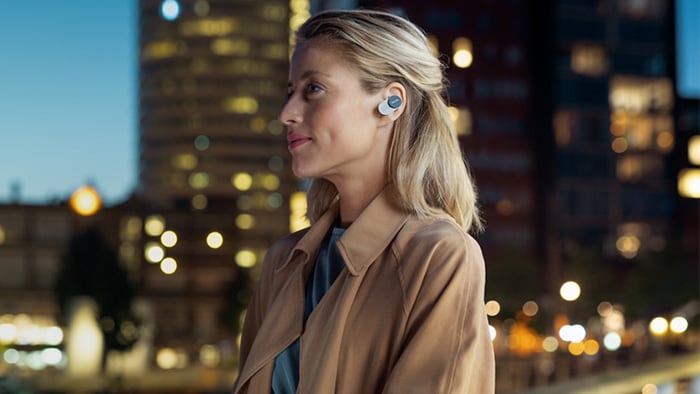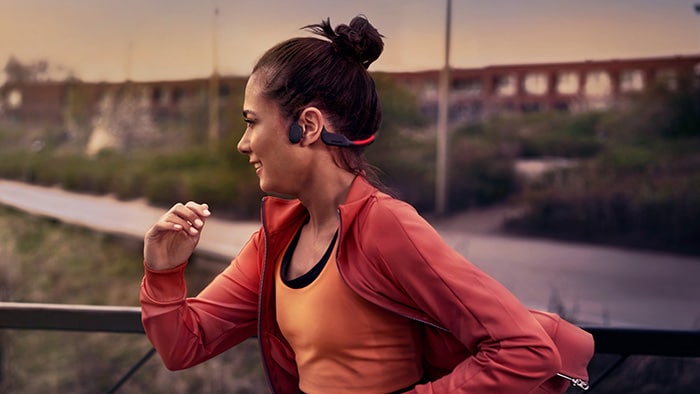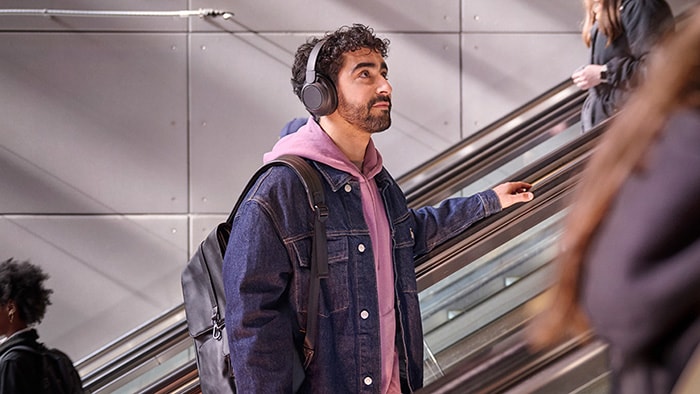Choosing the right sports headphones
From running and lifting to walks in the park, exercise is always better with a soundtrack! Sports headphones aren’t just a nice extra to have if you want to work out with tunes or listen to a podcast while you run—they’re essential gear. But do you want wireless sports headphones or true wireless sports earbuds—and what’s the difference between waterproof and water resistant anyway? If you’ve spent any time at all looking at the options, you’ll know that choosing the right pair of sports headphones can be daunting. Don’t worry. We’re here to help. Read on to discover more about the different types of headphones for running, cycling, general fitness, and other sports or forms of exercise.
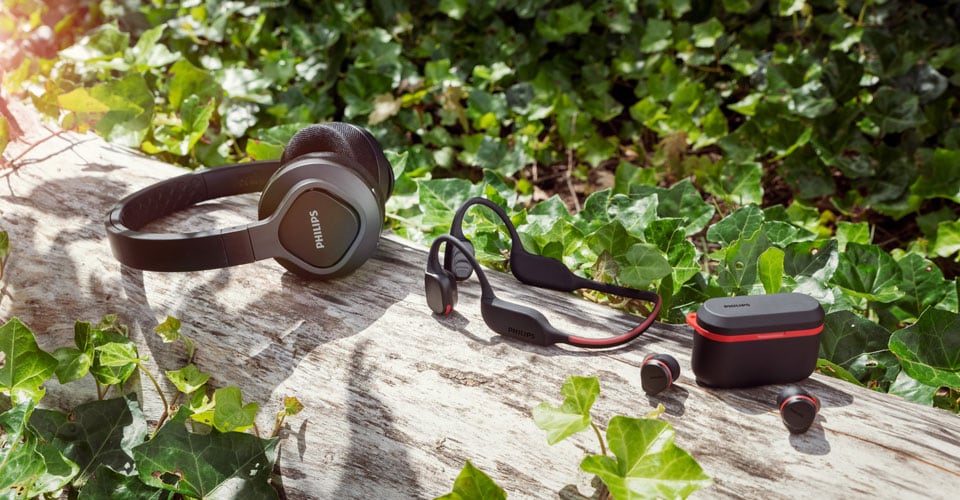
What makes a great pair of sports headphones?
Different activities will give you different priorities for what you want from a pair of sports headphones. If you cycle, for example, you’ll have safety and fit considerations that you don’t have in a gym. That said, there are a few overall things to check off for any pair of sports headphones—let’s call them baseline attributes that your earbuds or cans (over- or on-ear headphones) need to have if you want to move while wearing them.
Go for a comfy fit you can rely on
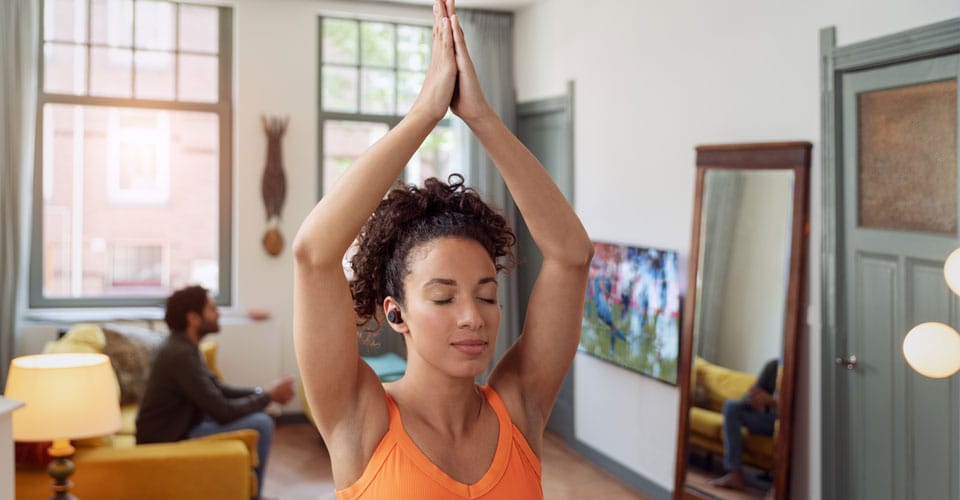
Sounds obvious, but sports headphones need to be lightweight—and they need to stay in place when you move. That’s why a secure, comfortable fit is number one on our list here. Doesn’t matter what you love to do: whether you’re working towards your best time on a 10k run, preparing for a big lift, or taking a brisk walk along your local beach, your enjoyment will be ruined if your headphones can’t keep up with you. So, which style of headphone will give you the most reliable fit? This is largely a matter of personal preference. There are three main styles of sports headphone: headband-style sports headphones, earbud-style sports headphones, and open-ear sports headphones. Each style has specific design features to make them fit securely—and, these days, most sports headphones in each style are wireless or true wireless.
What’s the difference between true wireless and wireless sports headphones?
When we say wireless, it’s worth noting that there are degrees to which your sports headphones will ditch the wires. Wireless sports headphones do, in fact, have a wire (often called a ‘neckband’) that connects the earbuds or headphone cups to each other. Sports headphones with no wires at all are known as true wireless headphones. If you’ve worked out with wired headphones before, you’ll probably relish the freedom of movement that a new pair of wireless sports headphones or true wireless earbuds will give you. But what are the different form factors—and which sports are they best for?
Almost invariably, the latest sports headphones are wireless. While you can still go wired, it’s easier to do a workout with wireless sports headphones: there are no wires to get tangled up in for starters! Wireless sports headphones connect to your smart devices via Bluetooth, which offers a super-strong and steady connection these days—your tunes will keep going for as long as you.
Headband-style sports headphones
Headband-style sports headphones have ear cups and a headband that fits over your head. Sports headphones with ear cups that surround your ear are called ‘over-ear’ sports headphones, and models with ear cups that sit on your ears are called ‘on-ear’ sports headphones.
Over-ear sports headphones: best for walking and light exercise
Over-ear headphones feature ear cups that completely envelop your ear. Some people find this super comfy, and the ear cups of wireless over-ear headphones designed for sports are usually super lightweight. But comfort isn’t the only reason you might like over-ear headphones: one of the main benefits to the earcups is passive noise isolation, which is a fancy way to say that the ear cups insulate your ears from some of the sounds going on around you. This helps you hear your music better. Over-ear sports headphones are bigger than any other type of sports headphone, which means they have more space for bigger speakers—or drivers, in headphone terminology. In higher-end models, the bigger drivers (speakers) allow for an inspiring sound, often with rich bass and sparkling higher frequencies.
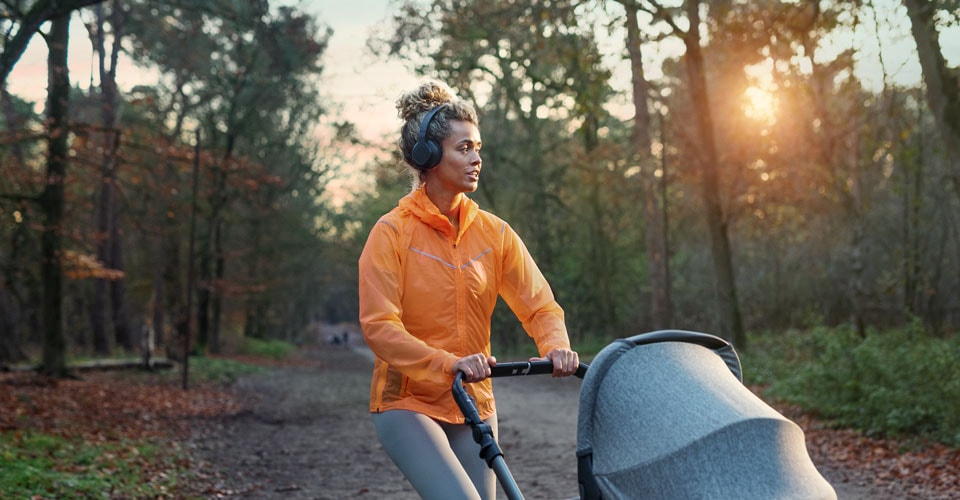
Some people find that the around-the-ear seal created by the ear cups on over-ear headphones can cause your ears to heat up, particularly if you are exercising. Some of the latest over-ear sports headphones boast features designed to counter this—like the Philips A4216, which have breathable ear cups filled with cooling gel to help keep you, well, cool. And they’re removable for quick and simple cleaning too. Compared to models that are not designed for exercise use, over-ear sports headphones also tend to be more durable—offering features like splash/sweat resistance. Wireless over-ear sports headphones are an ideal choice for low-impact exercise like walking, or some gym sessions. And if you like the comfort factor of the ear cups, then they’re a great way to listen to breathing exercises while meditating too. The over-ear fit is unlikely to answer your needs if you’re a runner, though. The motion of running will inevitably make even the most secure-fitting over-ear headphones joggle up and down on your head.
On-ear sports headphones: great for low-intensity workouts and the gym
Generally smaller and more lightweight, wireless on-ear sports headphones are better suited to slightly more intense activity than over-ear models. If you’re wearing them in the gym, they’re less likely to move when you’re squatting, deadlifting, or doing light treadmill work. However, on-ear headphones may still slide down your head when you’re doing exercises that put you in prone or supine positions—like some Pilates movements, or bench presses. Again, like their over-ear cousins, you can buy on-ear sports headphones with removable ear cups, which are also filled with cooling gel—such as the Philips A4216. Love headband sports headphones if: you’re into walking or low-intensity exercise, or you want a headband fit for the gym.
Earbud-style sports headphones
Wireless or true wireless earbuds: probably the most widely appropriate form factor for the biggest range of sports.
That’s not to say that earbud-style sports headphones are the only choice. Your own personal preference for fit should always play a role in your decision. Some people simply don’t like having earbuds in their ears (if you don’t like anything in your ear, you can look at our sections on headband-style sports headphones, above, and open-ear sports headphones, below).
However, if you’re perfectly happy to have an earbud sitting in your ear—then you’re going to have plenty of models to choose from. Indeed, the world of sports earbuds is growing so fast that choosing a pair can quickly get confusing.
For a start, there are two fits to choose from: earbuds with ear tips that go into the ear canal (also called in-ear sports headphones)—and earbuds that sit in the outer ear. It’s worth understanding a little more about the two fits, because each has specific attributes that might influence your choice.
In-ear sports headphones: a perfect seal in your inner ear
When earbuds are referred to as having an ‘in-ear’ fit, it means the tip of the earbud sits inside the opening of your ear canal. You’ll find that many in-ear sports headphones come with a selection of soft ear-tip covers, so you can mix and match for your perfect fit. No two ears are the same, so you’ll need to experiment: you may find that you want one size of ear-tip cover in one ear, and a different size in the other one.
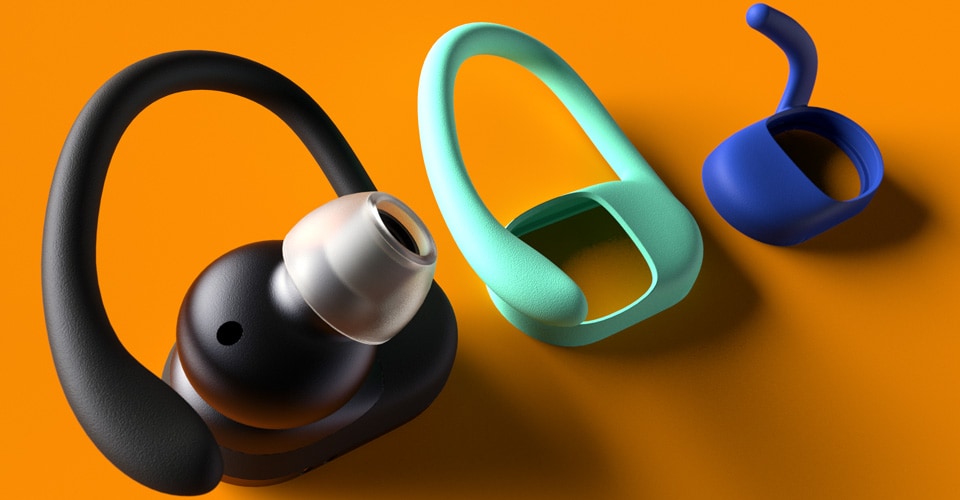
So, what’s the benefit of an ear-tip cover? Well, first it creates a perfect seal in your inner ear. This seal helps to isolate you from external sound, so you’ll hear your music and not your fellow gym-goers clanking away at their stations! Also, the seal does a decent job of holding the earbud in place, which is great if you’re running. If you’re into high-intensity workouts, it’s worth looking for in-ear sports headphones that come with a stabiliser of some kind. A stabiliser is an ear fin or wing tip, and they’re often shipped in multiple sizes so you can find your ideal fit. Generally, stabilisers attach to the round part of the earbud and tuck into the folds of your outer ear to hold the bud in place. If the sports earbuds you’re looking at don’t have stabilisers, they may ship with ear hooks, which loop over the top of the ear to hold everything steady. With an ear tip and stabilisers (or ear hooks) fitted, you can jump, cartwheel, backflip, or just throw out your best dance moves: your earbuds aren’t going anywhere.
Earbud sports headphones: a familiar fit that doesn’t intrude
Other earbud-style sports headphones fit inside your ear, without digging into the ear canal. They fit like the buds you used to get with every smartphone back in the day—and with every Walkman and Discman and MP3 player. If you’re old enough, they might be familiar to you! And if you have no idea what we’re talking about, but you know you don’t like the feeling of ear-tips going into your ear canal – then you’ll probably find this old-school style of earbud more comfortable. Watch out though: unless you find sports earbuds like this that also come with stabilisers or ear hooks, they might dislodge when you’re doing more kinetic gym work—or running. If plyometrics or skipping are regularly on your training menu, play it smart: you’ll be better off with in-ear headphones (the buds with ear tips, which we covered above) or open-ear headphones (you can read more on those below).
Wireless and true wireless sports earbuds: the basics
Ready for more? Let’s dive a little deeper into the difference between wireless and true-wireless earbud-style sports headphones. Depending on what you want from your sports headphones, there are pros and cons to both.
Wireless earbuds for sports: more freedom to move
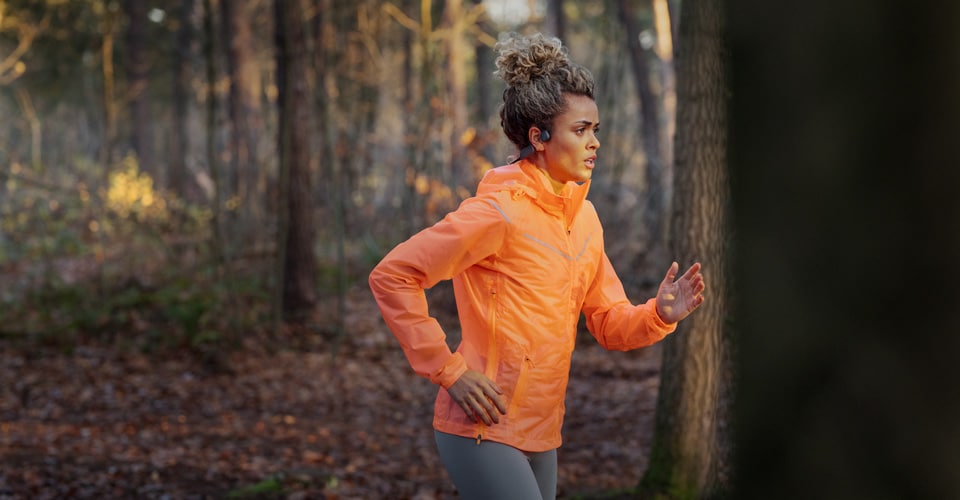
Wireless sports earbuds still have a wire (or cable) that connects the two earbuds together. This wire makes a neckband, which loops around the back of your neck, and you may see them referred to as ‘neckband earbuds’. When you’re running, jumping, or dancing, the neckband will move. This isn’t usually a problem, even if you’re really going for it.
Look out for handy design features, such as shirt clips that let you fix the neckband cable in place—and reflective cables for added safety on evening and night runs. Or those early morning winter runs!
True wireless earbuds for sports: the freest fit of all
True wireless sports headphones are earbuds that have no wires of any kind. You put an earbud in each ear and—that’s it—you’re ready to go!
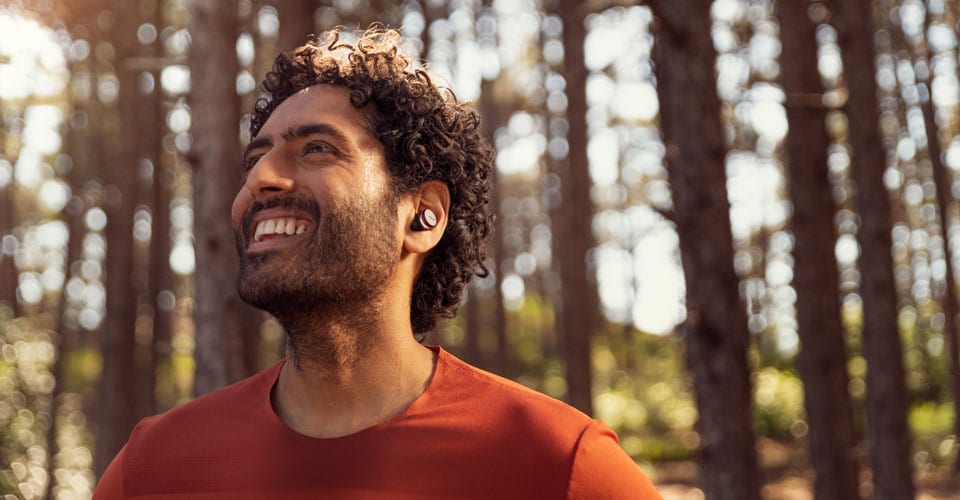
What about when you’re racing down the track, or doing inverted sit-ups off the top of a power rack? Unlike true wireless earbuds designed for everyday use, those designed for sports typically offer in-ear tips and ear hooks—or stabilisers (an ear fin or wing tip)—to keep them in place while you move. Some models, like the Philips A7306, even come with a choice of detachable ear hooks or wing tips so you can customise them to suit your needs and get an incredibly secure fit.
Love wireless sports earbuds if: you love to move, don’t want ear cups covering your ears, and you don’t mind a neckband.
Love true wireless sports earbuds if: you want to move without restrictions of any kind.
Open-ear sports headphones
If you’re someone who doesn’t like the feeling of anything sitting in—or over—your ears, bone-conducting open-ear sports headphones might just be your dream come true.
Instead of going in your ear, the speakers on bone-conducting headphones sit on your cheekbones—just in front of each ear. A soft, flexible neckband wraps around the back of your head to gently but firmly hold the speakers in place on your cheekbones, and ear hooks go over your ears to prevent them from slipping (if you’re a cyclist, the neckband sits low enough for you to wear a helmet).
When you fire up the latest podcast, the soundwaves (or vibrations) pass from the speaker to the bones in your inner ear so you can hear what’s being said. Meanwhile, your ears are completely open and free!
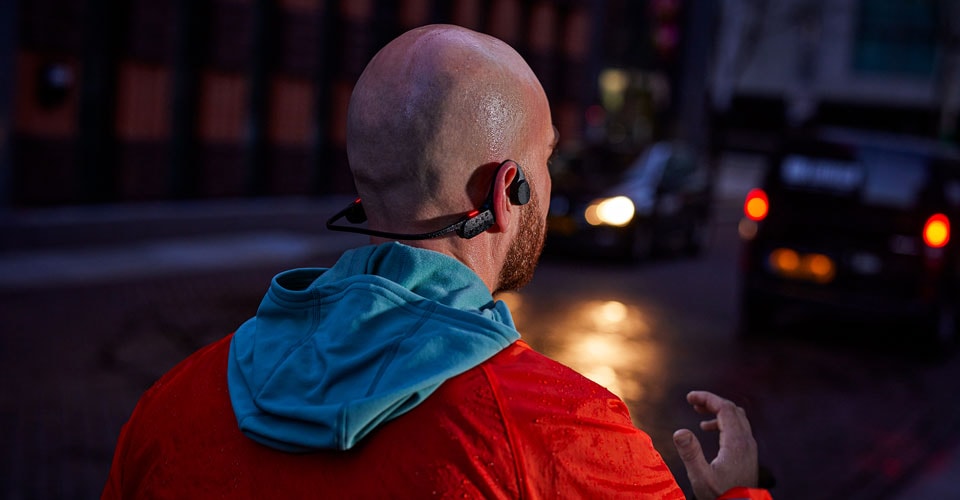
Whether you’re looking for running headphones or cycling headphones, bone-conducting open-ear headphones score high for safety. You’ll hear the cars if you’re cycling on open roads. And you’ll hear that cyclist’s bell if your running route takes you alongside—or on—roads, too.
(If you want to dive deep into how bone-conduction headphones work, check out our article here.)
In terms of sound, bone-conducting sports headphones are a compromise. You’ll still hear your music, but you won’t get all the detail or bass you would from sports earbuds or headband-style sports headphones. Podcasts and audiobooks are where bone-conducting headphones do well: your latest thriller can sound pretty awesome while you’re pounding the pavement or pedalling an extra 10k!
Love open-ear sports headphones if: you run or cycle and want to hear the outside world for safety. Or if you just don’t want anything in or on your ears.
Sports headphones and safety
There’s no getting away from it: exercise is a) brilliant and b) potentially dangerous. And that makes safety a consideration you can’t simply overlook.
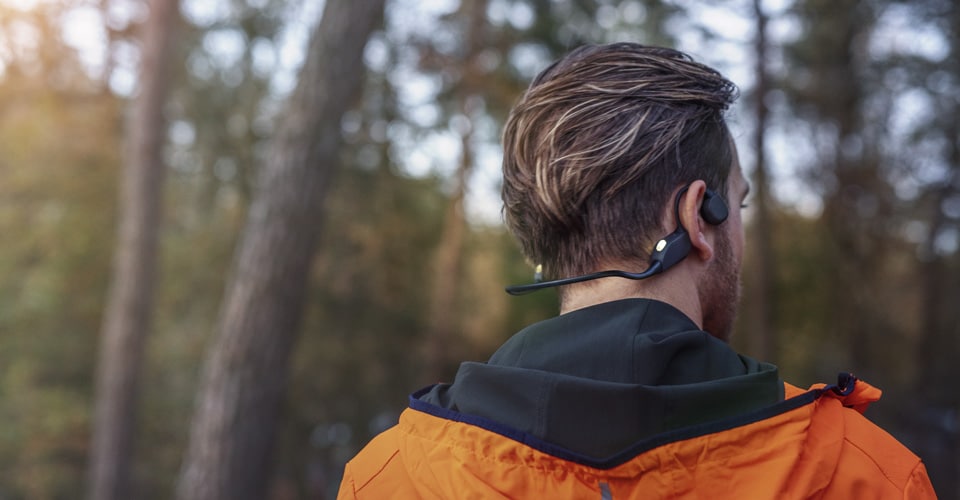
When you’re moving quickly and possibly erratically (definitely not judging how you run or ride here!), it’s pretty important that you can hear things you might hit. Or which might hit you. Open-ear sports headphones are one way to do this, but they’re not the only game in town. When you train outside, you also want to be seen. Many Philips sports headphones feature visibility aids—like running lights and reflective neckbands. Obviously if you’re running, walking, or cycling in dimly lit places, you should be wearing other reflective gear as well. But it’s worth checking to see if the sports headphones on your shortlist offer extra features like these.
If you’re not competing at amateur or pro level where open-ear headphones are the only ones you’re allowed to wear in a race, then the safest way to train is with sports headphones that feature Active Noise Cancellation (ANC). If you’ve researched any kind of headphone in the last two or three years, you almost certainly will have encountered this term. This ever-evolving technology uses microphones and noise-cancelling algorithms to selectively block out external noise.
We won’t go too deeply into ANC right now (for a big, all-encompassing look into noise cancellation, see our article on it here), but the headline is: you can use ANC to block the external sounds you don’t want to hear, and you can use it to let critical sounds back in. In terms of safety, it’s the ability to let critical sounds back in that really counts.
Philips ANC sports headphones with Awareness Mode let you do exactly this. If you come up to a busy intersection on your run, you can activate the mode and instantly hear the traffic.
Waterproof? Understanding IP ratings on your sports headphones
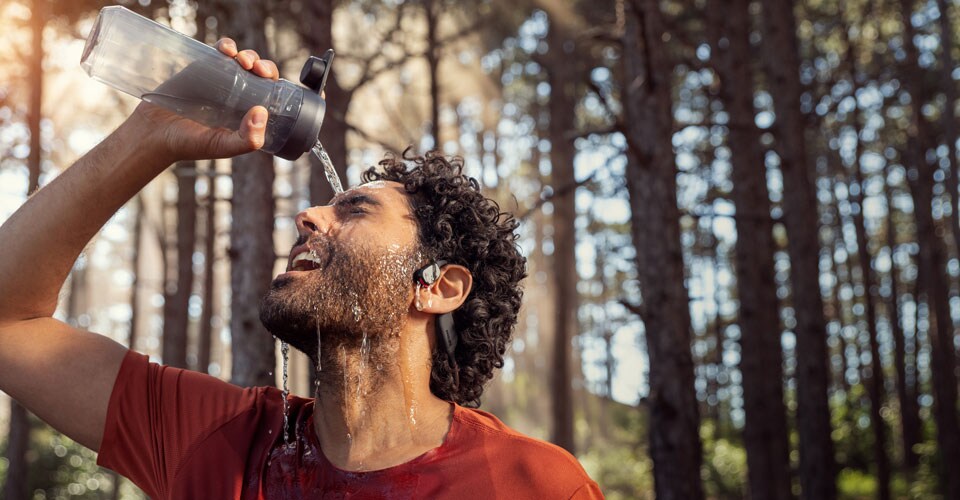
If there’s one thing all sports headphones have in common, it’s that they’re built to be tough. To find out just how tough, you need to check the IP rating which tells you how waterproof and/or dustproof a pair of headphones is.
It’s broken down like this:
IPXX
The IP stands for ‘ingress protection’, and the XX will be numbers that tell you respectively how well the headphones resist solids and liquid.
The first number in your headphones’ IP rating will always be fairly high, because it refers to how well a headphone’s outer casing protects its inner workings from solids. High numbers show that a product is protected against the accidental ingress of tiny particles (i.e., dust), while low numbers show that a product is protected against accidental intrusion from much larger things (like fingers or screwdrivers).
The second number tells you how waterproof your headphones are.
Basically, the higher the numbers the more dustproof or waterproof the headphones are. And when we say water—that includes sweat!
Understanding the IP rating on your sports headphones
Sweaty workouts, dusty trails, and rainy days
If you want to stick to a training schedule despite the rain or be free to hit those dusty trails with your headphones on—a quick check of the IP ratings above will help you choose the right pair.
For example, an IPX5 rating is more than sufficient for any activity that makes you sweat, or for training in the rain (so, you’ll no longer have an excuse for sacking off a run because it’s a bit wet outside). And an IP55 rating will let you get outside and sweat in the rain and the dust!
The Philips A7507 true wireless sports headphones are rated IPX5, which means they’re not rated for dust protection but are effective against water jets—so you can happily run in the rain while you’re wearing them. And the Philips A4216 on-ear headphones are rated IP55, which means dust won’t bother them at all, and they’re safe in the rain as well.
It’s important to note that if you want to swim with sports headphones on, you need to make sure you’re buying specifically designated swimming headphones. If the headphones don’t say ‘For Swimming’, don’t go in the water while you’re wearing them—not even if they do have a high IP rating.
Can sports headphones help me train better?
Can running headphones or cycling headphones help you run or ride better—can sports headphones that are ideal for use in the gym inspire you to get better lifts? Obviously, there’s a sense in which all sports headphones help you train better. They give you the music that keeps your energy up and pushes you further. Your workout playlist might be different to someone else’s—that’s the beauty of personal taste—but we bet the music makes you feel powerful and ready to step, stride, or ride your way to your next training milestone. And then there are the podcasts and audiobooks you might use to take your mind off the pain!
But, beyond the music and the podcasts—there are other advantages to getting a pair of sports headphones.
Higher, further, faster, stronger! Sports headphones with features to help you train
Our watches can tell us how much oxygen is in our blood. Our fridges can remind us to order more orange juice. But what about sports headphones? Some sports headphones —like the Philips A7306 —feature smart functions that are compatible with popular training apps. These true wireless earbuds boast a built-in heart rate monitor, which is compatible with the Philips Headphones app as well as some training apps. If your chosen app supports live updates, you’ll get heart-rate readings spoken into your ear while you train. If you’re looking to train smarter by pushing yourself at the right time, a function like this can help.
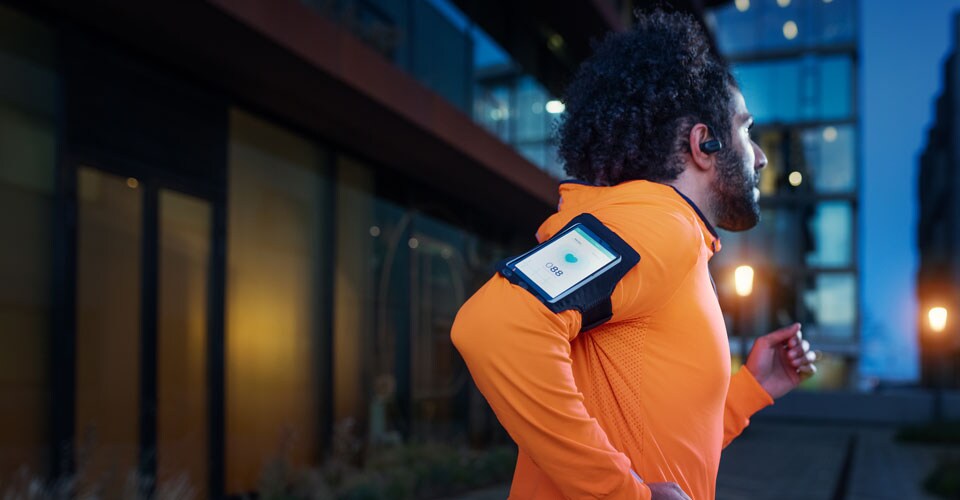
Other sports headphones pack some clever tech into their charging cases. Like the Philips A7306 true wireless earbuds: when you pop the buds back in their case after a workout, a UV cleaning cycle removes 99% of bacteria. Take the earbuds out before your next session and they’ll be fully charged and clean—ready for you to sweat all over again.
Run another mile, do another set: How long do wireless sports headphones last between charges?
Remember how we talked about pretty much all sports headphones being wireless—and sports earbuds being wireless or true wireless—and how great that was for sports and workouts of all kinds?
Whether you’re an everyday walker or a serious gym goer, wireless sports headphones give you plenty of freedom to move. But they also give you the unenviable job of trying to work out what all those battery-life figures mean!
Headband and open-ear sports headphones: one playtime figure to rule them all
If you’re looking at headband-style sports headphones, it’s pretty simple to understand how long they will run from a single charge. You’ll see one figure on the box, which indicates the playtime you can expect from using your headphones within normal parameters. Once you have exceeded this figure, the battery will deplete, and you’ll need to plug in a charging cable to charge them up again. It’s also worth noting the length of time your headphones will take to fully charge from empty, and whether they have a quick-charging function to give you an extra boost. Plenty of sports headphones will offer a feature that gives you an extra hour’s playtime, or similar, after a quick 15-minute blast on charge.
How much playtime you get depends on all sorts of things, including whether your headphones have Active Noise Cancellation (ANC)—and whether ANC affects battery life on that particular set (in some cases, it won’t). Around 20 hours playtime between charges is standard, but some headband-style sports headphones boast monster figures of over 30 hours. Meaning you can train for a whole week before you even have to think about charging them again!
Open-ear headphones are the same: you’ll see one figure indicating how much playtime you can expect between charges.
Wireless and true wireless sports earbuds: multiple plays from a charging case
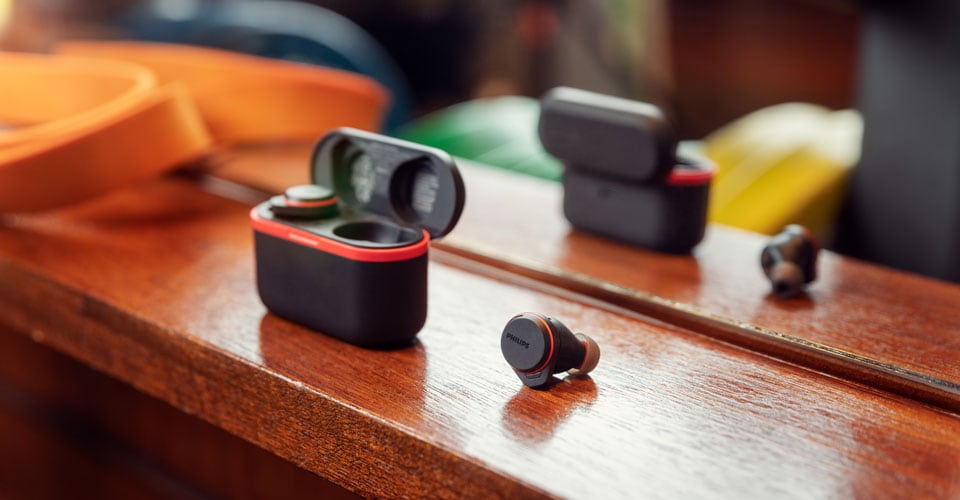
With wireless and true wireless sports headphones, the earbuds are usually charged in their case—the case itself doubles as a charger. So far, so simple. Where it can get confusing is that you won’t see one playtime figure on the box, but you’ll see what looks like a simple sum: something like 6+18. And just like with IP ratings, understanding what this means is all about knowing how to read the numbers. Once your charging case is fully charged, it holds more power than is required for a single charge of your earbuds. The additional power that the charging case holds is why you’ll find the two playtime figures (which look like an addition sum) on the box. The smaller figure tells you how long a pair of fully charged earbuds should run before they need to go back in the charging case. The larger figure tells you how many extra hours playtime you can put into your earbuds by charging them again.
Before we get to that, it can be helpful to understand that a charging case is essentially a power bank, in which your headphones sit. This means that the case itself also needs charging—just like any other power bank. Charging cases are usually charged via a cable or wireless charging pad.
Let’s say your chosen sports headphones have 6+18 hours of playtime. This means that one full charge will get the earbuds playing for roughly 6 hours. And a fully charged case will hold an extra 18 hours of power.
So, if you charge the buds up fully—and charge the case up fully—you can head out knowing that you have up to 24 hours of training time in your pocket (the 6 hours in the buds, plus 18 hours extra in the case). Which means you can do a workout for 2 hours, pop the buds back in the case, and repeat 12 times before you’d need to charge the case up again!
Multiple sessions in one day? This is how you’ll always have enough juice for more
There’s no doubt that these small charging cases are super handy, but it’s worth checking to see if the earbuds you’re considering have a quick-charging feature too.
It usually takes around two hours to fully charge a set of wireless or true wireless sports headphones when you put them back in the case. Plenty of time between sessions! But what if you were to keep your earbuds in after your morning workout so you can enjoy your tunes on your way back from the gym…and then you use your buds during your lunch break, and now you want to go on an evening run?
That’s where earbuds with a quick-charging feature can save the day! This will let you get an extra hour or two of playtime simply by popping the earbuds back into their charging case for a short time (usually around 15 minutes).
-
6000 series
On-ear solar-powered headphones
TAA6219BK/00
- Powerfoyle™ solar technology
- Self-charging headphones
- 80-hour battery reserve
- Washable ear-cup cushions
-
Open-ear wireless sports headphones
TAA5608BK/00
- Open-ear fit
- Bone conduction
- Clearer calls on the go
- LED safety lights
-
6000 series
Open-ear true wireless sports headphones
TAA6709BK/00
- Open-ear true wireless fit
- Air conduction
- IP55 dust/water protection
- Up to 28 hours of play time




